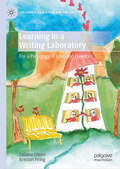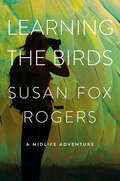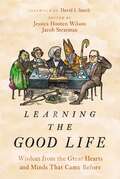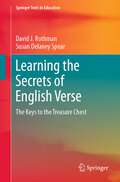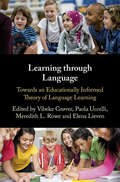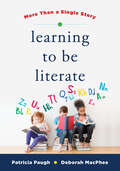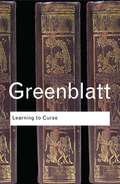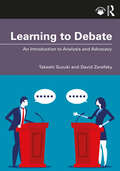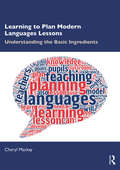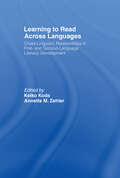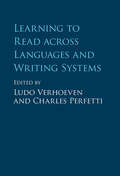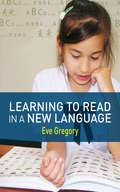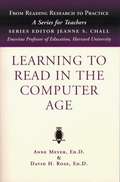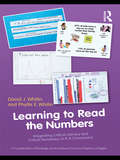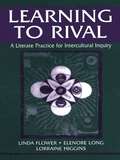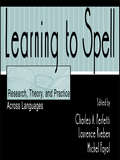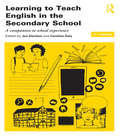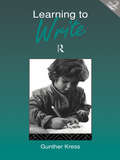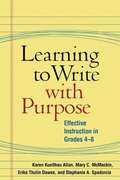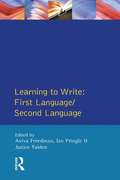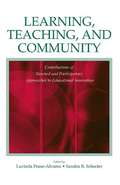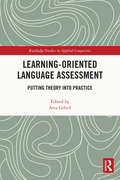- Table View
- List View
Learning in a Writing Laboratory: For a Pedagogy of Love and Freedom (Creativity, Education and the Arts)
by Tatiana Chemi Kristian FiringThis book is an exploration of a collective writing laboratory designed to stimulate creativity and critical reflection for education professionals. The authors uncover how a writing lab can help educators develop their teaching practices and identities by means of critical-creative, collaborative, relational and arts-based methodologies. A theoretical insight into pedagogies of love and freedom illustrating how laboratory practices in education can become acts of daily care, the book will appeal to students and scholars of education, arts-based methods and creativity.
Learning the Birds: A Midlife Adventure
by Susan Fox Rogers"The thrill of quiet adventure. The constant hope of discovery. The reminder that the world is filled with wonder. When I bird, life is bigger, more vibrant." That is why Susan Fox Rogers is a birder. Learning the Birds is the story of how encounters with birds recharged her adventurous spirit. When the birds first called, Rogers was in a slack season of her life. The woods and rivers that enthralled her younger self had lost some of their luster. It was the song of a thrush that reawakened Rogers, sparking a long-held desire to know the birds that accompanied her as she rock climbed and paddled, to know the world around her with greater depth. Energized by her curiosity, she followed the birds as they drew her deeper into her authentic self, and ultimately into love. In Learning the Birds, we join Rogers as she becomes a birder and joins the community of passionate and quirky bird people. We meet her birding companions close to home in New York State's Hudson Valley as well as in the desert of Arizona and awash in the midnight sunlight of Alaska. Along on the journey are birders and estimable ornithologists of past generations—people like Franklin Delano Roosevelt and Florence Merriam Bailey—whose writings inspire Rogers's adventures and discoveries. A ready, knowledgeable, and humble friend and explorer, Rogers is eager to share what she sees and learns. Learning the Birds will remind you of our passionate need for wonder and our connection to the wild creatures with whom we share the land.
Learning the Good Life: Wisdom from the Great Hearts and Minds That Came Before
by Jacob Stratman Jessica Hooten WilsonDiscover the Good Life as You Learn from the Wise Voices of the PastWe've lost ourselves. Disconnected from the past and uncertain about the future, we are anxious about what our lives will be and troubled by a nagging sense of meaninglessness. Adrift in the world, many Christians have their identity completely wrapped up in work and their definition of the "good life" is financial success. Fewer of are staying committed to the Christian faith, finding it difficult to reconcile their experience with their longings and desires. With so much uncertainty, where can we find a true vision of "the Good Life"?Learning the Good Life speaks to this malaise with trusted and assured voices from the past, inviting Christians into an age-old conversation with some of history's wisest hearts and minds as their dialogue companions. Featuring classic writings from a diverse lineup of over 35 writers and thinkers including Confucius, Augustine, Sor Juana Inés de la Cruz, W.E.B. DuBois, Flannery O'Connor, and Wendell Berry. Together these sages of the past address important issues such as:VocationCallingMeaningSufferingBeautyVirtueLearningWisdomCritical ThinkingCommunityWonderReflectionAnd moreEach of these texts are introduced by experts who are teachers, from a variety of Christian colleges and universities, to help providing a broader, richer, and more cohesive narrative in which Christians may participate. In addition to a substantive introduction, each text is accompanied by discussion questions to provoke further thought and contemplation and also to facilitate discussion when used in groups. Ideal for any Christian seeking a deeper connection to the wisdom of the past and wanting a more cohesive and beautiful vision of the good life. All the writers have a message for you. All of them are calling you to die to yourself, to your habits of indulgence, to your pride and ambition, and instead, dedicate your time to learning, thinking, and loving.Writers and writings featured in Learning the Good Life include:Lao Tzu, From Tao Te ChingConfucius, SelectionsPlato, The Allegory of the CaveSeneca the Younger, "On the Shortness of Life"Athanasius, On the IncarnationGregory of Nazianzus, On My Own VersesAugustine, On the TeacherAugustine, On Christian Doctrine, Book I.Pope Gregory the Great, Life of Saint Benedict, Dialogues, Book 2Dante Alighieri, The Divine Comedy, Inferno 1Nezahualcoyotl, "A Flower Song of Nezahualcoyotl"Margery Kempe, From "The Book of Margery Kempe"William Shakespeare, King LearJohn Amos Comenius, From The Labyrinth of the World and the Paradise of the HeartGeorge Herbert, Five PoemsBlaise Pascal, SelectionsMatsuo Basho, Three Haiku PoemsSor Juana Ines de la Cruz, "Respuesta a Sor Filotea de la Cruz"John Milton, AreopagiticaJonathan Edwards, "Personal Narrative"Edmund Burke, Reflections on the Revolution in FranceLord Alfred Tennyson, "Ulysses"Frederick Douglass, Narrative LifeElizabeth Barrett Browning, from Aurora LeighHenry David Thoreau, "Life Without Principle"Gerard Manley Hopkins, "As Kingfishers Catch
Learning the Secrets of English Verse: The Keys to the Treasure Chest (Springer Texts in Education)
by David J. Rothman Susan Delaney SpearThis textbook teaches the writing of poetry by examining all the major verse forms and repeating stanza forms in English. It provides students with the tools to compose successful lines of poetry and focuses on meter (including free verse), rhythm, rhyme, and the many other tools a poet needs to create both music and meaningfulness in an artful poem. Presenting copious examples from strong poets of the past and present along with many recent student examples, all of which are scanned, each chapter offers lessons in poetic history and the practice of writing verse, along with giving students a structured opportunity to experiment writing in all the forms discussed. In Part 1, Rothman and Spear begin at the beginning, with Anglo-Saxon Strong Stress Alliterative Meter and examine every major meter in English, up to and including the free verse forms of modern and contemporary poetry. Part 2 presents a close examination of stanza forms that moves from the simple to the complex, beginning with couplets and ending with the 14-line Eugene Onegin stanza. The goal of the book is to give students the essential skills to understand how any line of poetry in English may have been composed, the better to enjoy them and then also write their own: the keys to the treasure chest. Rothman and Spear present a rigorous curriculum that teaches the craft of poetry through a systematic examination and practice of the major English meters and verse forms. Under their guidance, students hone their craft while studying the rich traditions and innovations of poets writing in English. Suitable for high school students and beyond. I studied with Rothman in graduate school and went through this course with additional scholarly material. This book will help students develop a keen ear for the music of the English language.—Teow Lim Goh, author of Islanders
Learning through Language: Towards an Educationally Informed Theory of Language Learning
by Vibeke Grøver Paola Uccelli Meredith Rowe Elena LievenLearning language and using language to learn is at the core of any educational activity. Bringing together a globally representative team of experts, this volume presents an innovative and empirically robust collection of studies that examine the role of language in education, with a particular emphasis on features of school-relevant language in middle childhood and adolescents, and its precursors in early childhood. It addresses issues such as how children's linguistic and literacy experiences at home prepare them for school, how the classroom functions as a language-mediated learning environment, and how schools can support language minority students in academic attainment. Set in three parts - Early Childhood, Middle Childhood and Adolescence and Learning in Multilingual Contexts - each part features a discussion from experts in the field to stimulate conversation and further routes for research. Its structure will make it useful for anyone interested in ongoing efforts towards building a pedagogically relevant theory of language learning.
Learning to Be Literate: More Than a Single Story
by Patricia Paugh Deborah MacPheeThere is not one right way to teach a child to read. Recent media stories about education have featured the “Science of Reading,” whose proponents typically present the systematic teaching of phonics as a one-size-fits-all method that guarantees reading success for all students. But as literacy scholars Patricia Paugh and Deborah MacPhee demonstrate, the decoding of words is only one of many skills that are central to an effective early literacy education. In Learning to Be Literate, they present a four-part framework for active literacy learning that eschews oppositional arguments about different approaches, and instead situates children as meaning makers: the whole point of being literate. There is no single or simple solution that will fit every child. But by using the ALL framework to inform instruction, educators can help young learners think deeply about ideas and language at the same time as they learn to work out the sounds and symbol systems of language.
Learning to Curse: Essays in Early Modern Culture
by Stephen GreenblattStephen Greenblatt argued in these celebrated essays that the art of the Renaissance could only be understood in the context of the society from which it sprang. His approach - 'New Historicism' - drew from history, anthropology, Marxist theory, post-structuralism, and psychoanalysis and in the process, blew apart the academic boundaries insulating literature from the world around it. Learning to Curse charts the evolution of that approach and provides a vivid and compelling exploration of a complex and contradictory epoch.
Learning to Debate: An Introduction to Analysis and Advocacy
by David Zarefsky Takeshi SuzukiWritten in an accessible style, this textbook introduces undergraduate students to the theoretical and practical aspects of debate and outlines the fundamental skills of analysis and advocacy.Debate teaches students how to solve the problems that we face in everyday and public situations. This book allows readers to face such problems head on by equipping them with the knowledge and skills to analyze a situation, propose solutions, and present debates and arguments in a persuasive manner. Organized into two parts, the book begins by laying the theoretical foundations and offering a step-by-step guide to debate. Students are shown how to compare pros and cons, test evidence and reasoning, and defend and develop their own positions. Each chapter in part two explores key sample constructive, rebuttal, and summary debate speeches and includes exercises and assignments to allow students to actively engage with the material and experience debate in the classroom.Providing students with the tools to become responsible members of a democratic society, Learning to Debate: An Introduction to Analysis and Advocacy is an ideal textbook for undergraduate Argumentation and Debate and Speech Communication courses.Material for instructors, including PowerPoint slides and an instructor’s manual, is available at https://routledge.com/9781032671390.
Learning to Die in London, 1380-1540
by Amy ApplefordTaking as her focus a body of writings in poetic, didactic, and legal modes that circulated in England's capital between the 1380s--just a generation after the Black Death--and the first decade of the English reformation in the 1530s, Amy Appleford offers the first full-length study of the Middle English "art of dying" (ars moriendi). An educated awareness of death and mortality was a vital aspect of medieval civic culture, she contends, critical not only to the shaping of single lives and the management of families and households but also to the practices of cultural memory, the building of institutions, and the good government of the city itself. In fifteenth-century London in particular, where an increasingly laicized reformist religiosity coexisted with an ambitious program of urban renewal, cultivating a sophisticated attitude toward death was understood as essential to good living in the widest sense. The virtuous ordering of self, household, and city rested on a proper attitude toward mortality on the part both of the ruled and of their secular and religious rulers. The intricacies of keeping death constantly in mind informed not only the religious prose of the period, but also literary and visual arts. In London's version of the famous image-text known as the Dance of Death, Thomas Hoccleve's poetic collection The Series, and the early sixteenth-century prose treatises of Tudor writers Richard Whitford, Thomas Lupset, and Thomas More, death is understood as an explicitly generative force, one capable (if properly managed) of providing vital personal, social, and literary opportunities.
Learning to Plan Modern Languages Lessons: Understanding the Basic Ingredients
by Cheryl MackayLearning to Plan Modern Languages Lessons contains a wealth of guidance and ideas for those learning to teach in secondary schools. Drawing on extensive experience and research in the field, it offers detailed explanation of basic lesson planning methods and the principles that underpin them, illustrated by worked examples of well-planned lessons. The book shows how to progress from planning smaller activities to full lessons to sequences of lessons, and how to ensure progression for your students. Specific aspects of language learning such as grammar and culture are explored, together with ideas for how to make your planning skills more effective in long-term collaborative and reflective practice. Starting from a presentation, practice, production (PPP) model of language teaching, the book aims to: provide structured, practical starting points in lesson planning for beginning teachers of modern languages (ML); deepen knowledge and understanding of ML as a subject and how it is learnt (pedagogical subject knowledge), in order to inform and support planning decisions; develop understanding of lesson planning as part of a planning cycle; enhance understanding of strategies and professional development opportunities to promote the further development of planning abilities. Including reflective/discussion tasks and example lesson plans Learning to Plan Modern Languages Lessons is a must-read book for beginning and more experienced teachers of any modern language.
Learning to Read Across Languages: Cross-Linguistic Relationships in First- and Second-Language Literacy Development
by Keiko Koda Annette M. ZehlerThis book systematically examines how learning to read occurs in diverse languages, and in so doing, explores how literacy is learned in a second language by learners who have achieved at least basic reading skills in their first language. As a consequence of rapid globalization, such learners are a large and growing segment of the school population worldwide, and an increasing number of schools are challenged by learners from a wide variety of languages, and with distinct prior literacy experiences. To succeed academically these learners must develop second-language literacy skills, yet little is known about the ways in which they learn to read in their first languages, and even less about how the specific nature and level of their first-language literacy affects second-language reading development. This volume provides detailed descriptions of five typologically diverse languages and their writing systems, and offers comparisons of learning-to-read experiences in these languages. Specifically, it addresses the requisite competencies in learning to read in each of the languages, how language and writing system properties affect the way children learn to read, and the extent and ways in which literacy learning experience in one language can play a role in subsequent reading development in another. Both common and distinct aspects of literacy learning experiences across languages are identified, thus establishing a basis for determining which skills are available for transfer in second-language reading development. Learning to Read Across Languages is intended for researchers and advanced students in the areas of second-language learning, psycholinguistics, literacy, bilingualism, and cross-linguistic issues in language processing.
Learning to Read across Languages and Writing Systems
by Ludo Verhoeven Charles PerfettiAround the world, children embark on learning to read in their home language or writing system. But does their specific language, and how it is written, make a difference to how they learn? How is learning to read English similar to or different from learning in other languages? Is reading alphabetic writing a different challenge from reading syllabic or logographic writing? Learning to Read across Languages and Writing Systems examines these questions across seventeen languages representing the world's different major writing systems. Each chapter highlights the key features of a specific language, exploring research on learning to read, spell, and comprehend it, and on implications for education. The editors' introduction describes the global spread of reading and provides a theoretical framework, including operating principles for learning to read. The editors' final chapter draws conclusions about cross-linguistic universal trends, and the challenges posed by specific languages and writing systems.
Learning to Read in a New Language: Making Sense of Words and Worlds
by Eve Gregory'[This book] is a helpful edition to a field where there is a limited amount of good literature to support teachers dealing with second language acquisition in the classroom' - ESCalate `Gregory's book is an important and timely contribution to the literature on literacy, biliteracy, second language learning and early childhood education, synthesizing cutting-edge research, perspectives and teaching approaches in a clear and accessible way. Overall, it is a terrific resource' - Dinah Volk Across the world, an increasing number of young children are learning to read in languages different from their mother tongue, and there is a clear need for a book which addresses the ways in which these children should be taught. Eve Gregory's book is unique in doing so. Building upon the ideas proposed in Making Sense of a New World, this second edition widens its scope, arguing for the limitations of policies designed for 'monolingual minds' in favour of methodologies which put plurilingualism at the centre of literacy tuition. This book offers a practical reading programme -- an 'Inside-Out' (starting from experience) and 'Outside-In' (starting from literature) approach to teaching which can be used with individuals, small groups and whole classes. It uses current sociocultural theory, while drawing on examples of children from America, Australia, Britain, China, France, Singapore, South Africa and Thailand who are engaged in learning to read nursery rhymes and songs, storybooks, letters, the Bible and the Qur'an as well as school texts, in languages they do not speak fluently. Gregory argues that, in order for literacy tuition to be successful, reading must make sense -- children must feel part of a community of readers. There is no common method which they use to learn, but rather a shared aim to which they aspire: making sense of a new world through new words. Eve Gregory is Professor of Language and Culture in Education at Goldsmiths, University of London.
Learning to Read in the Computer Age
by Anne Meyer David H. RoseThe computer and the Internet loom larger each year in the school lives of many children. This book acquaints the parent and teacher with the applicable computer function for a reading task and sample cutting edge software.
Learning to Read in the Late Ottoman Empire and the Early Turkish Republic
by Benjamin C. FortnaAn exploration of the ways in which children learned and were taught to read, against the background of the transition from Ottoman Empire to Turkish Republic. This study gives us a fresh perspective on the transition from empire to republic by showing us the ways that reading was central to the construction of modernity.
Learning to Read the Numbers: Integrating Critical Literacy and Critical Numeracy in K-8 Classrooms. A Co-Publication of The National Council of Teachers of English and Routledge
by David J. Whitin Phyllis E. WhitinBeing a critical reader of numerical information is an integral part of being literate in today’s data-drenched world. Uniquely addressing both mathematics and language issues, this text shows how critical readers dig beneath the surface of data to better evaluate their usefulness and to understand how numbers are constructed by authors to portray a certain version of reality. Engaging, concise, and rich with examples and clear connections to classroom practice, it provides a framework of critical questions that children and teachers can pose to crack open authors’ intentions, expose their decisions, and make clear who are the winners and losers – questions that are essential for building democratic classrooms. Explaining and illustrating how K-8 teachers can engage students in developing the ability to be both critical composers and critical readers of texts, Learning to Read the Numbers is designed for teacher education courses across the areas of language arts, mathematics, and curriculum studies, and for elementary teachers, administrators, and literacy and mathematics coaches. Learning to Read the Numbers is a co-publication of The National Council of Teachers of English (www.ncte.org) and Routledge.
Learning to Rival: A Literate Practice for Intercultural Inquiry (Rhetoric, Knowledge, and Society Series)
by Linda Flower Elenore Long Lorraine HigginsLearning to Rival tells the inside story of college and high school writers learning to "rival"--to actively seek rival hypotheses and negotiate alternative perspectives on charged questions. It shows how this interdisciplinary literate practice alters with the context of use and how, in learning to rival in school and out, students must often negotiate conflicts not apparent to instructors. This study of the rival hypothesis stance--a powerful literate practice claimed by both humanities and science--initially posed two questions: * how does the rival hypothesis stance define itself as a literate practice as we move across the boundaries of disciplines and genres, of school and community? * how do learners crossing these boundaries interpret and use the family of literate practices, especially in situations that pose problems of intercultural understanding? Over the course of this project with urban teenagers and minority college students, the rival hypothesis stance emerged as a generative and powerful tool for intercultural inquiry, posing in turn a new question: how can the practice of rivaling support the difficult and essential art of intercultural interpretation in education? The authors present the story of a literate practice that moves across communities, as well as the stories of students who are learning to rival across the curriculum. Learning to Rival offers an active, strategic approach to multiculturalism, addressing how people negotiate and use difference to solve problems. In the spirit of John Dewey's experimental way of knowing, it presents a multifaceted approach to literacy research, combining contemporary research methods to show the complexity of rivaling as a literate practice and the way it is understood and used by a variety of writers. As a resource for scholars, teachers, and administrators in writing across the curriculum studies, writing program administration, service learning, and community based projects, as well as literacy, rhetoric, and composition, this volume reveals how learning a new literate practice can force students to encounter and negotiate conflicts. It also provides a model of an intercultural inquiry that uses difference to understand a shared problem.
Learning to Spell: Research, Theory, and Practice Across Languages
by Michel Fayol Charles A. Perfetti Laurence RiebenThis distinctive cross-linguistic examination of spelling examines the cognitive processes that underlie spelling and the process of learning how to spell. The chapters report and summarize recent research in English, German, Hebrew, and French. Framing the specific research on spelling are chapters that place spelling in braod theoretical perspectives provided by cognitive neuroscience, psycholinguistic, and writing system-linguistic frameworks. Of special interest is the focus on two major interrelated issues: how spelling is acquired and the relationship between reading and spelling. An important dimension of the book is the interweaving of these basic questions about the nature of spelling with practical questions about how children learn to spell in classrooms. A motivating factor in this work was to demonstrate that spelling research has become a central challenging topic in the study of cognitive processes, rather than an isolated skill learned in school. It thus brings together schooling and learning issues with modern cognitive research in a unique way. testing, children writing strings of letters as a teacher pronounces words ever so clearly. In parts of the United States it can also bring an image of specialized wizardry and school room competition, the "spelling bee." And for countless adults who confess with self-deprecation to being "terrible spellers," it is a reminder of a mysterious but minor affliction that the fates have visited on them. Beneath these popular images, spelling is a human literacy ability that reflects language and nonlanguage cognitive processes. This collection of papers presents a sample of contemporary research across different languages that addresses this ability. To understand spelling as an interesting scientific problem, there are several important perspectives. First, spelling is the use of conventionalized writing systems that encode languages. A second asks how children learn to spell. Finally, from a literacy point of view, another asks the extent to which spelling and reading are related. In collecting some of the interesting research on spelling, the editors have adopted each of these perspectives. Many of the papers themselves reflect more than one perspective, and the reader will find important observations about orthographies, the relationship between spelling and reading, and issues of learning and teaching throughout the collection.
Learning to Teach English in the Secondary School: A companion to school experience (Learning to Teach Subjects in the Secondary School Series)
by Jon Davison Caroline DalyHow do you approach teaching English in the contemporary classroom? What is expected of a would-be English teacher? The fourth edition of this best-selling text combines theory and practice to present an indispensable introduction to the opportunities and challenges of teaching English in the secondary classroom. It offers insight into the history, policies and definitions surrounding the subject, together with innovative and practical strategies which can be used for effective teaching and learning. Already a major text for many university teacher education courses, the new edition reflects the extent and impact of current reforms whilst retaining its focus on what is of enduring value for English teaching. With an emphasis on developing your own values and on stimulating approaches that underpin English teaching, it will help you navigate your way through changing curriculum requirements, assessment practice and the demands of professional development. Key topics explored include: Reading, writing and speaking and listening Teaching language and grammar Drama in English teaching Poetry Working with digital technologies Post-16 English language and literature Developing as a critically reflective practitioner. Written particularly with the new and student teacher in mind, Learning to Teach English in the Secondary School aims to equip readers with the tools to make critically informed judgements about how to teach, develop principled practice and most importantly, be mindful of pupils and their experience of English in the secondary classroom.
Learning to Write
by Gunther KressFirst published in 1982, this influential and classic text poses two questions: what is it that a child learns when he or she learns to write? What can we learn about children, society and ourselves, by looking at this process? The book is based on a close analysis of a series of written texts by primary school children and is written for student teachers with little or no knowledge of linguistics. In this new edition, Gunther Kress has made extensive revisions in the light of recent developments in linguistics and in education. The theoretical focus is now a social semiotic one, which allows a fundamental rethinking of issues such as 'preliteracy' and broad social and cultural questions around the making of texts.
Learning to Write with Purpose
by Stephanie A. Spadorcia Erika Thulin Dawes Mary C. Mcmackin Karen Kuelthau AllanCommunicating ideas and information is what makes writing meaningful-yet many upper elementary and middle school students write in a vacuum, without considering the aims of their writing or the needs of their readers. This highly informative, teacher-friendly book presents a fresh perspective on writing instruction along with practical methods for the classroom. Teachers learn ways to promote the skills and strategies needed to write and revise effectively in a range of genres: personal narratives, fiction, and poetry; persuasive, explanatory, and "how-to" writing; and writing for high-stakes tests. Special features include vivid classroom vignettes, examples of student work, evaluation guidelines, and suggested "mentor texts" that model different genres.
Learning to Write: First Language/Second Language (Applied Linguistics and Language Study)
by Aviva Freedman Ian Pringle Janice YaldenFirst published in 1983. Routledge is an imprint of Taylor & Francis, an informa company.
Learning, Teaching, and Community: Contributions of Situated and Participatory Approaches to Educational Innovation
by Lucinda Pease-Alvarez and Sandra R. SchecterThis volume brings together established and new scholarly voices to explore how participatory and situated approaches to learning can contribute to educational innovation. The contributors' critical examinations of educational programming and engagements provide insights into how educators, youth, families, and community members understand and enact their commitments to diversity and equitable access. Collectively, these essays complicate notions of community, alerting readers to ways in which community can be constructed other than in geographical and ethnoracial terms--as alliances and collaborations of individuals joining together to accomplish or negotiate shared agendas. The focus on agency combined with social context, a dialectic to which all of the authors speak, enlarges and invigorates our sense of what is pedagogically possible in societies characterized by diversity and flux. *Part I, "Linking Pedagogy to Communities," focuses on dynamic initiatives where practitioners collaborate with community members and other professionals as they acknowledge and build on the cultural, linguistic, and intellectual resources of ethnic-minority students and their communities. *Part II, "Professional Learning for Diversity," centers on the authors' experiences in facilitating opportunities for working with prospective and practicing teachers to develop situated pedagogies, highlighting both the challenges that emerge and the transformations that occur. *Part III, "Learning in Community (and Community in Learning), illustrates how educational innovation can extend beyond the realm of schools and classrooms by elucidating ways in which individuals construct learning venues in out-of-school settings. Learning, Teaching, and Community: Contributions of Situated and Participatory Approaches to Educational Innovation is a compelling and timely text ideally suited for courses focused on teacher education and development, informal learning, equity and education, multilingual and multicultural education, language and culture, educational foundations, and school reform/educational restructuring, and will be equally of interest to faculty, researchers, and professionals in these areas.
Learning-Oriented Language Assessment: Putting Theory into Practice (Routledge Studies in Applied Linguistics)
by Atta GebrilThis collection brings together research on learning-oriented language assessment from scholars working across geographic and educational contexts, highlighting the opportunities of assessment practices which seek to better align assessment and learning tasks and support effective learning. The volume begins by introducing learning-oriented assessment (LOA) and the context around its growing popularity, especially in accountability-oriented settings which favor summative large-scale tests. The first part of the book charts the development of LOA’s theoretical and conceptual underpinnings, outlining the ways in which they have been informed by theories of learning and key elements. The second part demonstrates LOA in practice, drawing on examples from different countries and instructional settings to explore such topics as the role of technology in LOA and developing feedback materials based around LOA principles and developed for core literacy skills. Offering a holistic view of learning-oriented assessment and the real-world affordances and challenges of its implementation, this book is key reading for graduate students, researchers, and practitioners in language testing and assessment, TESOL, and language education.
Learning-Oriented Language Assessment: Putting Theory into Practice (Routledge Studies in Applied Linguistics)
by Atta GebrilThis collection brings together research on learning-oriented language assessment from scholars working across geographic and educational contexts, highlighting the opportunities of assessment practices which seek to better align assessment and learning tasks and support effective learning. The volume begins by introducing learning-oriented assessment (LOA) and the context around its growing popularity, especially in accountability-oriented settings which favor summative large-scale tests. The first part of the book charts the development of LOA’s theoretical and conceptual underpinnings, outlining the ways in which they have been informed by theories of learning and key elements. The second part demonstrates LOA in practice, drawing on examples from different countries and instructional settings to explore such topics as the role of technology in LOA and developing feedback materials based around LOA principles and developed for core literacy skills.Offering a holistic view of learning-oriented assessment and the real-world affordances and challenges of its implementation, this book is key reading for graduate students, researchers, and practitioners in language testing and assessment, TESOL, and language education.
